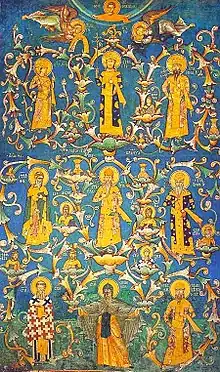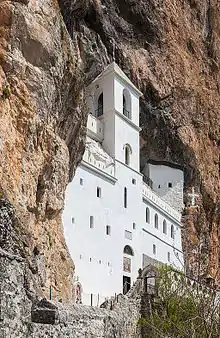Stefan Nemanja
Stefan Nemanja (Serbian Cyrillic: Стефан Немања, pronounced [stêfaːn ně̞maɲa]; ca 1113 – 13 February 1199) was the Grand Prince (Veliki Župan) of the Serbian Grand Principality (also known as Raška, lat. Rascia) from 1166 to 1196. A member of the Vukanović dynasty, Nemanja founded the Nemanjić dynasty, and is remembered for his contributions to Serbian culture and history, founding what would evolve into the Serbian Empire, as well as the national church. According to the Serbian Academy of Sciences and Arts, Nemanja is also among the most remarkable Serbs for his literary contributions and altruistic attributes.[1]
| Stefan Nemanja | |||||
|---|---|---|---|---|---|
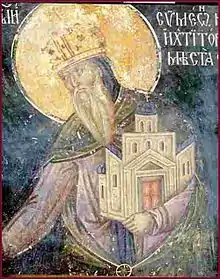 Donor's portrait of Stefan Nemanja, fresco in the Virgin's Church of the Studenica Monastery | |||||
| Grand Prince of Serbia | |||||
| Reign | 1166–1196 | ||||
| Coronation | 1166 | ||||
| Predecessor | Stefan Tihomir | ||||
| Successor | Stefan II Nemanjić | ||||
| Born | 1113/4 Ribnica | ||||
| Died | 13 February 1199 Monastery of Hilandar | ||||
| Burial | |||||
| Spouse | Anastasia of Serbia | ||||
| Issue |
| ||||
| |||||
| Dynasty | Nemanjić | ||||
| Father | Zavida | ||||
| Religion | → Roman Catholic → Eastern Orthodox (re-baptised) | ||||
In 1196, after three decades of warfare and negotiations which consolidated Serbia while distinguishing it from both Western and Byzantine spheres of influence, Nemanja abdicated in favor of his middle son Stefan Nemanjić, who became the first King of Serbia. Nemanja ultimately went to Mount Athos, where he became a monk and took the name of Symeon, joining his youngest son (later known as Saint Sava), who had already become the first archbishop of the Serbian Orthodox Church.
Together with his son Sava, Nemanja restored the Hilandar Monastery at Mount Athos from 1198–1199, and issued the "Charter of Hilandar". The monastery later became the cradle of the Serbian Orthodox Church. The Serbian Orthodox Church canonized Stefan Nemanja shortly after his death under the name Saint Simeon the Myrrh-streaming (Свети Симеон Мироточиви) after numerous miracles.
Early life
Nemanja was born around the year 1113 AD in Ribnica, Zeta (in the vicinity of present-day Podgorica, the capital of Montenegro). He was the youngest son of Zavida, a Prince of Zahumlje, who after a conflict with his brothers was sent to Ribnica where he had the title of Lord. Zavida (Beli Uroš) was most probably a son of Uroš I or Vukan. Since western Zeta was under Roman Catholic jurisdiction, Nemanja received a Latin baptism,[2] although much of his later life was spent balancing Western and Eastern forms of Christianity.
After Byzantine armies defeated Nemanja's kinsmen Đorđe of Duklja and Desa Urošević, leading to the decline of that branch of the Vojislavljević family, Zavida took his family to their hereditary lands at Raška. Upon arriving in Ras, the capital of Raška, Nemanja was re-baptised in the Eastern Orthodox Church, in the Church of St. Apostles Peter and Paul which was an episcopal see.
Byzantine-Hungarian War
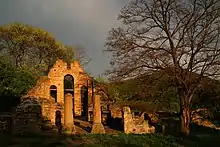
In 1163, Emperor Manuel I Comnenus came to Niš with the army via Serdica (Sofia), where, according to John Kinnamos, he decided "to deal with things concerning Serbia". At that time, Serbia was ruled by the grand zoupan (archzupan or megajupanus) Desa, an ally of Stephen III in the Hungarian dynastic conflicts, and thus an opponent of Manuel. When Desa was finally forced to come to Niš before the emperor, his connections with the Hungarian king Stephen III were revealed, Desa called him his master, Manuel I decided to take him to court and punish him. Desa was first detained and kept under guard, and then sent to the court prison in Constantinople.
In Raska, he replaced the grand zoupan Desa, who entered into an alliance with the Hungarians, and instead gave the land to the administration of Zavida's sons, who were in the pro-Greek party. Zavida had four sons: Tihomir, Stracimir, Miroslav and the youngest Nemanja. Tihomir was the oldest and became the grand zoupan of Raška. He was recognized by the brothers who ruled certain parts of Raška. Stracimir held the areas around West Morava, Miroslav Zahumlje, while Stefan Nemanja held the areas around Ibar, Toplica and Dubocica (around Leskovac). Stefan Nemanja was married to Anastasia, with whom he had three sons, Rastko, Stefan and Vukan, and daughters Vuk, Deva and Efimija
The Byzantine emperor Manuel I Comnenus launched a large army against Hungary because he was informed of their dissatisfaction and internal conflicts. The Hungarian prince Bela III had to live in Constantinople, where he was married, and Bela's lands, Dalmatia with southern Hungary (below Velebit), had to come under Constantinople's rule. There is resistance in Hungary, which is why Emperor Manuel embarks on a campaign. The Byzantine army conquered Zemun and Srem in 1165. The Greeks were accompanied by the obligatory detachments of Serbs. The second Byzantine army moved west, across Raška and Bosnia towards the Adriatic coast. Without significant resistance, they took all the cities from Split to Bar, forcing them to recognize Byzantine rule.
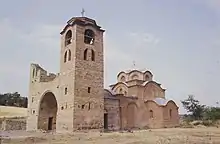
The Byzantines also had success in a campaign in Italy where they captured an important seaport on the west coast of the Adriatic, Ancona. Venice, which had previously turned to Byzantium for help during the conquest of Friedrich Barbarossa in northern Italy, changed its attitude towards the Greeks for fear of losing the Adriatic. It approached Hungary as a natural ally against the Greeks. At the same time, they began to work among the Serbs, especially in Raška, in order to rebel against Byzantium.
In 1166, the Hungarians counterattacked to push Byzantium out of the newly conquered areas. However, in response, Emperor Manuel launched three armies against Hungary, one from the Danube, and the other two across the Carpathians, towards the center of Pannonia. While the main Hungarian army was operating towards the Danube, Belgrade and Braničevo, two Byzantine armies went deep into their territory, causing general panic. The Hungarians were forced to seek peace through intermediaries to their detriment in 1167.
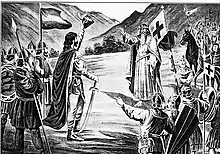
As the ideal candidate of Venice and Hungary among the Serbs appeared Nemanja, when his brothers and, above all, the grand zoupan Tihomir imprisoned him in a cave near Fortress Ras. Nemanja probably hoped that he would take the place of Desa, as the former representative of the pro-Greek party, while Emperor Manuel brought his eldest brother Tihomir to the throne. Angry because of that, Nemanja changes his policy in favor of Hungary and its allies. Nemanja escaped from the dungeon, it is not known with whose help. Nemanja's son and biographer, Stefan Nemanjić, describing his father's youth, says how he escaped with the help of "heavenly forces": "And this again, because of meekness and justice, and wonderful humility, and because of all good customs, with a high arm he brought him out of the rocky cave, and brought him to the throne of his fatherland, and raised him up as the great lord."
Rise to the throne (1168-1172)
In 1168, Nemanja gathered his supporters in Ras (Ras Fortress) and started a conflict against Tihomir, who was looking for support from the Greeks. Nemanja overthrew Tihomir, but he managed to survive with the help of Byzantium. The decisive battle between the brothers took place near Pantina in Kosovo in 1170, in which Tihomir's army was defeated, and he was drowned with armor during retreat in the river Sitnica.

In the same year, Nemanja attacked the Byzantine vassal, Prince of Zeta Radoslav, and on that occasion annexed to his country a part of the then Zeta and the Neretva region. The following year, Manuel I Komnenos came into conflict with the Venetian Republic, and on his order, on March 12, 1171, all Venetian property in Byzantium was confiscated. In response to this, from Venecia was launched Venetian navy with about 120 ships to Byzantine possessions. The Venetian fleet headed east in September of that year, conquering, by the way, Byzantine Trogir and Dubrovnik. Then Nemanja entered into closer ties with the Venetians and began attacks on Byzantine Kotor, simultaneously carrying out raids through the Moravian valley through which the main public road passes between Byzantine Belgrade and Niš.
Kingdom of Hungary also joined the fight against Byzantium, and the Holy Roman Empire of Frederick Barbarossa (1152-1190), also supported this alliance. Nemanja expected Hungarian help, but in the meantime, king Stephen III of Hungary died on March 4, 1172. The Hungarian emissaries went to Serdica (Sofia), where Emperor Manuel encamped with the army, preparing for the campaign. The Hungarian throne was won by Manuel's candidate Bela III (1173-1196). In the meantime, during the winter of 1171/72 on the island of Chios, the Venetian army was decimated by an epidemic, so that the Serbs were left alone in the fight against Byzantium. Manuel immediately took advantage of the favorable moment and after receiving the Hungarian emissaries, he headed for the Serbs at the head of the army. Before the oncoming Byzantine army, the grand zoupan Nemanja retreated to the mountains.
According to the Byzantine historian John Kinnamos, the Venetians incited Nemanja to revolt.
Byzantine vassal (1172-1182)
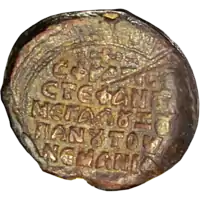
This conflict ended with Nemanja's surrender to Emperor Manuel. One day, Nemanja ritually obeyed Manuel I Komnenus. Barefoot, with his clothes torn to the elbows, a rope around his neck and a sword in his hands, he entered the Byzantine camp and went out to the emperor. Arriving in front of Manuel, he fell on his knees in front of him, handing him his sword, to do with him what he wanted. The Byzantine emperor accepted his humility, agreeing to the renewal of vassal obligations and leaving Nemanja in the position of grand zoupan. The final part of this episode took place in Constantinople, where was Nemanja was taken as a slave in Manoel's triumphal procession, while the gathered people ridiculed him.
The Byzantine emperor Manuel Comnenus returned Nemanja to the position of grand zoupan, and he confirmed to his brothers their areas - Stracimir around the West Moravia and Miroslav Zachlumia. Upon his return to Raška, Nemanja turned to consolidating the central government, and forced Tihomir's son and successor Prvoslav to renounce the ruler's claims in his favor.
In accordance with his vassal duties, Nemanja regularly sent auxiliary detachments to Byzantine military campaigns. Serbian detachments were also part of the Byzantine army that defeated the troops of the Sultanate of Rum in the battle of Myriokephalon on September 17, 1176 in the gorges of Asia Minor.
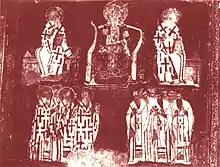
Bogumilism reached its peak in the Byzantine Empire during the 11th and in the first half of the 12th century. At the end of the 12th century, among Serbs and other Balkan Slavs, there was a very widespread Slavic Christian or dualistic teaching called Bogumilism. The main political tendency of Bogomilism was resistance to the Byzantine state and church authorities.
Bogumilism itself was very widespread among the people in Raška and Bosnia, and its spread among the nobles led to Nemanja's actions against them. He convened a state-church assembly at which a decision was to be made on further measures against them. The council was attended by Byzantine church dignitaries. On it, part of the nobles opposed any action against them, but in the end a decision was made to expel them from the country and punish them. The Bogumils opposed the decisions of the council with weapons, so that Nemanja waged a real war against them in which Bogumilism was destroyed. They were, however, mostly expelled from the state, their property burned and confiscated, while some of them remained in the country concealing their faith.
War with Byzantium (1183-1191)
After the death of Emperor Manoel on September 24, 1180, the Hungarian king Bela III considered that he had no more obligations to Byzantium. The following 1181, he launched an offensive against Byzantium and conquered Srem, the northeastern part of the Adriatic coast (Including Zara) and Zemun. Byzantium was then occupied by internal conflicts, so that there was no military response to the Hungarian conquests. In 1182, Bela III ordered an attack on Byzantine Belgrade and Braničevo. The attack itself was quite clumsily carried out, and both fortresses were defended by experienced military leaders from the time of Emperor Manoel, Alexius Branas and Andronikos Lapardas.
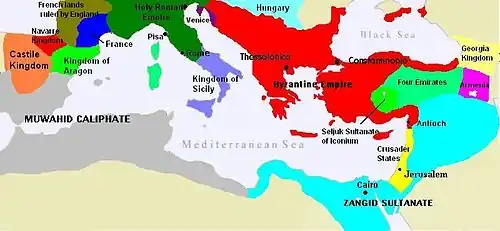
Following the death of Manuel I in 1180, his widow, the Latin princess Maria of Antioch, acted as regent to her infant son Alexios II Komnenos. Her regency was notorious for the favoritism shown to Latin merchants and was overthrown in April 1182 by Andronikos I Komnenos, who entered the city in a wave of popular support. Almost immediately, the celebrations spilled over into massacre of Latins.
The usurpation of Andronikos I freed Nemanja from subordination to the Byzantine emperor. Stefan Nemanja, in alliance with the Hungarian king Bela III, launched a great offensive on Byzantium in 1183. Also, the commander of the Byzantine army, Andronicus Lampardis in Niš and Braničevo, renounced obedience to the new central authorities. At the same time, the Hungarian king Bela III conquered Byzantine Belgrade, Niš and Serdica (Sofia). According to the Byzantine historian Niketas Choniates, the Serbs, led by Nemanja, joined this campaign. The following year, Nemanja launched an offensive on the southeastern Adriatic coast and conquered Byzantine Skadar and besieged Dubrovnik (Ragusa).
In 1185, Andronicus I was killed in Constantinople and the new Byzantine emperor Isaac II Angelos began peace negotiations with the Hungarian king. The peace treaty provided for Emperor Isaac II to marry Bela's daughter Margaret. The Hungarian army withdrew from the Byzantine central part of the Balkans, leaving Nemanja without support. Fortunately for Nemanja, at the same time, the Normans and the Bulgarians joined the anti-Byzantine alliance.
Nemanja forced Dubrovnik (Ragusa) to replace Byzantium with Norman rule. The Normans of king William II of Sicily, also in 1185, conquered Byzantine Durres and Thessaloniki, and embarked on an expedition to Constantinople, but they lost discipline due to large-scale looting, so the Byzantines easily defeated them in the battle of Demetritzes near Lower Struma. In October 1185, in the Lower Danube, in northern Bulgaria, an uprising began, led by the brothers Peter and Ivan I Asen, one of the reasons for which was an extraordinary tribute that Emperor Isaac II ordered to be collected for his wedding. During 1186 and 1187, Nemanja coordinated actions with the Asen brothers against Byzantium.
Between two Emperors
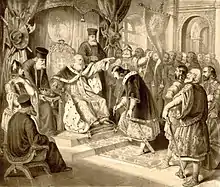
Meanwhile, Ayyubid sultan Saladin captured Jerusalem in 1187. Due to the fall of Jerusalem in the Latin West, there was a great commotion that started the Third Crusade. A large crusader army led by the German Emperor Frederick I Barbarossa marched in 1189 from Buda through Belgrade and Niš to Edirne and Constantinople.
In Niš, in the new capital of Stefan Nemanja, the German emperor and the grand zoupan met at the end of July 1189. At the meeting, Nemanja asked Barbarossa for the Crusaders to go to war against Byzantium. However, Barbarossa rejected this proposal in a diplomatic manner, wanting to ensure only a safe passage for his army through Byzantium. A month later, negotiations began between the Crusaders and the Byzantines over the passage with great tension. The Crusaders captured Philippopolis and Edirne and prepared for an attack on Constantinople. Finally, an agreement was reached on the crossing of the Dardanelles in February 1190. During the uncertain negotiations, Emperor Isaac II replied that the new friendship between the Crusaders and the Serbs was very difficult for him.
In 1190, the German Emperor Friedrich Barbarossa drowned in the river Calycadnus. At the same time, Emperor Isaac II Angelos launched a punitive expedition against the Serbs, and Nemanja was defeated in the battle of South Morava. In fact, Constantinople did not want to subdue the Serbs, but to regain Niš and the main road to Belgrade, as well as to make allies of the rebellious Serbs. The peace treaty provided for Stefan Nemanjić, the middle son of the grand zoupan Stefan Nemanja, to marry a Byzantine princess, i.e. nephew of the Byzantine emperor.
Return to Byzantium

The concluded peace envisaged that Nemanja would be succeeded by his middle son Stefan, who received the Byzantine title of sebastokrator and the Byzantine princess Eudokia for a wife, and not the firstborn Vukan.
Hungarian king Béla invaded Serbia at the beginning of 1193. Emperor Isaac II demanded the withdrawal of his troops, and threatened Béla with war. At the same time, Doge Enrico Dandolo attempted to occupy Hungarian Zara, but failed. In April 1195, the father-in-law of Stefan Nemanjić, Alexius III Angelus (1195-1203), overthrew his brother Emperor Isaac II and took power.
In 1196, at the state assembly near Church of Saints Peter and Paul, Stefan Nemanja abdicated the throne in favor of his middle son Stefan, who became the grand zoupan of Serbia. He left his eldest son Vukan in charge of Zeta, Travunija, Hvosno and Toplica. Nemanja became a monk in his old age and was given the name Simeon. Shortly afterwards, he went to Byzantium, to Mount Athos, where his youngest son Sava had been a monk for some time. They received permission from the new Byzantine emperor to rebuild the abandoned Hilandar monastery.
Death and legacy
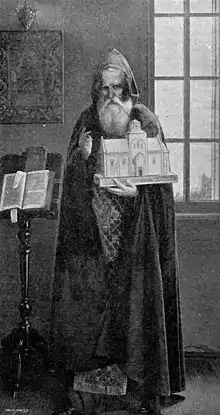
Knowing his death was near in his 86th year, Simeon asked to be placed on a mat in front of the icon of the Virgin Hodegetria with a stone for his pillow. He died in front of his son Sava and other monks, on 13 February 1200.[3] He was buried in the grounds of Hilandar monastery. His last words requested that Sava take his remains to Serbia, "when God permits it, after a certain period of time". Sava later wrote the Liturgy of Saint Simeon in Nemanja's honour.
In 1206 Sava brought his father's remains to Serbia, where his brothers were fighting a civil war and tearing apart the Serb lands their father had so painfully reunited. The two brothers made peace and returned to their demesnes. Simeon was re-buried in 1207 in his personal foundation, the Studenica Monastery, where holy oil again seeped, from his new grave. According to legend, holy oil (myrrh) seeped from Nemanja's tomb, thus his epithet the Myrrh-streaming. However, the miracle has not recurred in 300 years. Nonetheless, his remains are, even in modern times, reputed to emit "a sweet smell, like violets".[4] Because of this and numerous miracles, the Serbian Orthodox Church canonised him in 1200, and declared his feast-day on 26 February [O.S. 13 February]. The cult of St. Simeon helped consolidate Serb national identity, and still lives on in Studenica and among the monks of Mount Athos, who cherish his life and works as well as remains.
Name and title
Various names have been used to refer to Stefan Nemanja, including Stefan I and the Latin Stephanus Nemania. Sometimes the spelling of his name is anglicised, to become Stephen Nemanya. In the latter part of his life, he became a monk and hence was referred to as Monk Simeon or Monk Symeon. After his death, he was canonised by the Orthodox Church, and became St. Symeon the Myrrh-streaming. His son and successor, Stefan the First-Crowned, called him "The Gatherer of the Lost Pieces of the Land of his Grandfathers, and also their Rebuilder". His other son Sava, called him "Our Lord and Autocrat, and ruler of the whole Serbian land". In a way, both sons introduced the cult of their father, thus creating the ideal picture of a ruler-saint, without parallel in Byzantium.[5]
Family
Nemanja was married to a Serb noblewoman by the name of Ana. They had three sons and three daughters:
- Vukan Nemanjić - Prince of Doclea and briefly Grand Prince of Serbia (1202-1204)
- Stefan Nemanjić - Nemanja's successor, first King of All Serbian lands, 1196–1228
- Rastko Nemanjić (Saint Sava) (1171–1236) - The first archbishop and saint of the Serbian Orthodox Church
- Jefimija Nemanjić - married Manuel Komnenos Doukas Regent of Thesaloniki (+1241)[6][7]
- A daughter married Bulgarian nobleman Tihomir Asen, mother of Bulgarian emperor Konstantin Tih (r. 1257–77)
- Elena-Evgenia, wife of Ivan Asen I
Foundations
Stefan Nemanja founded, restored and reconstructed several monasteries. He also established the Raška architectural school, that spanned from 1170-1300.
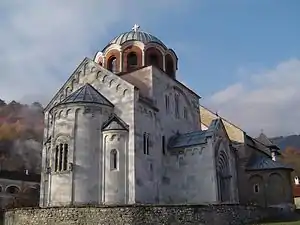
- Monastery of Saint Nicholas, in Kuršumlija
- Monastery of Saint Mother of Christ, between Kosanica and Toplica
- Monastery Temple of George's Tracts (Đurđevi Stupovi), in 1171 in Ras
- Monastery Temple of the Immaculate Holy Virgin the Benefactor (Studenica), in 1190 in Ibar
- Church of Saint Mother of Christ, at the confluence of the Bistrica and the Lim
- Monastery of Saint Nicholas, in Kaznovići/Končulj on the Ibar
- Nunnery of Mother of Christ, in Ras
Reconstructions
- Hilandar monastery on Mount Athos, in 1199
- Monastery of Saint Archangel Michael, in Skopje
- Monastery of Saint Pantheleimon, in Niš
Donations
- Church of Lord, Holy Grave and Christ's Arrisal, in Jerusalem
- Church of Saint John the Forerunner, in Jerusalem
- Church of Saint Theodosios, in the Desert of Bethlehem
- Church Saint Apostole Peter and Paul, in Rome
- Church of Saint Nicholas, in Bari
- Monastery/Church of the Virgin of Evergethide, in Constantinople
- Monastery/Church of Saint Demetrios, in Thessalonika
See also
References
- 100 najznamenitijih Srba. Serbian Academy of Sciences and Arts. 1993. ISBN 86-82273-08-X.; 1st place
- Fine 1994, p. 3
- Obolensky, pp. 126-127.
- Kindersley 1976, p. 23.
- Southeastern Europe in the Middle Ages, p. 390
- Marek, Miroslav. "Genealogy of the Nemanjić". genealogy.euweb.cz.
- Cawley, Charles (November 2016), /SERBIA: Efimijadied12181225, Medieval Lands database, Foundation for Medieval Genealogy,
Sources
- Bataković, Dušan T., ed. (2005). Histoire du peuple serbe [History of the Serbian People] (in French). Lausanne: L’Age d’Homme.
- Ćirković, Sima (2004). The Serbs. Malden: Blackwell Publishing.
- Curta, Florin (2006). Southeastern Europe in the Middle Ages, 500–1250. Cambridge: Cambridge University Press.
- Dvornik, Francis (1962). The Slavs in European History and Civilization. New Brunswick: Rutgers University Press.
- Fine, John Van Antwerp Jr. (1991) [1983]. The Early Medieval Balkans: A Critical Survey from the Sixth to the Late Twelfth Century. Ann Arbor, Michigan: University of Michigan Press.
- Fine, John Van Antwerp Jr. (1994) [1987]. The Late Medieval Balkans: A Critical Survey from the Late Twelfth Century to the Ottoman Conquest. Ann Arbor, Michigan: University of Michigan Press.
- Ivić, Pavle, ed. (1995). The History of Serbian Culture. Edgware: Porthill Publishers.
- Kindersley, Anne (1976). The Mountains of Serbia: Travels through Inland Yugoslavia. John Murray.
- Lins, Joseph (1912). . In Herbermann, Charles (ed.). Catholic Encyclopedia. 13. New York: Robert Appleton Company.
- Obolensky. Six Byzantine Portraits. Oxford: Clarenden Press. p. 116
- Obolensky, Dimitri (1974) [1971]. The Byzantine Commonwealth: Eastern Europe, 500-1453. London: Cardinal.
- Ostrogorsky, George (1956). History of the Byzantine State. Oxford: Basil Blackwell.
- Pavlowitch, Stevan K. (2002). Serbia: The History behind the Name. London: Hurst & Company.
- Samardžić, Radovan; Duškov, Milan, eds. (1993). Serbs in European Civilization. Belgrade: Nova, Serbian Academy of Sciences and Arts, Institute for Balkan Studies.
- Sedlar, Jean W. (1994). East Central Europe in the Middle Ages, 1000-1500. Seattle: University of Washington Press.
- Stanković, Vlada, ed. (2016). The Balkans and the Byzantine World before and after the Captures of Constantinople, 1204 and 1453. Lanham, Maryland: Lexington Books.
- Stanković, V. D. (2015). "Construction of the feudal state at the time of Stefan Nemanja". Baština (38): 45–55.
External links
| Wikimedia Commons has media related to Stefan Nemanja. |
- Serbian Unity Congress - Rulers of the Land
- Cawley, Charles, Medieval Lands Project - Serbia, Medieval Lands database, Foundation for Medieval Genealogy
- (in Serbian) History of the Serbs - Third Period - Stephen Nemanya, by Vladimir Ćorović
- (in Serbian) The Holy bloodline of Stefan Nemanja by Željko Fajfrić
- (in Serbian) The Holy bloodline of the Nemanjics - Stephen Nemanya
- (in Serbian) The Nemanjics - Stephen Nemanya
- CD Chilandar by Studio A, Aetos, Library of Serb Patriarchate and Chilandar monastery, Belgrade, 1998
Stefan Nemanja Born: 1114 Died: 13 February 1200 | ||
| Regnal titles | ||
|---|---|---|
| Preceded by Tihomir |
Grand Prince of Serbia 1166–1196 |
Succeeded by Stefan Nemanjić |
| Royal titles | ||
| Preceded by Mihailo III |
Prince of Doclea cc 1186–1190 |
Succeeded by Vukan |
.jpg.webp)
